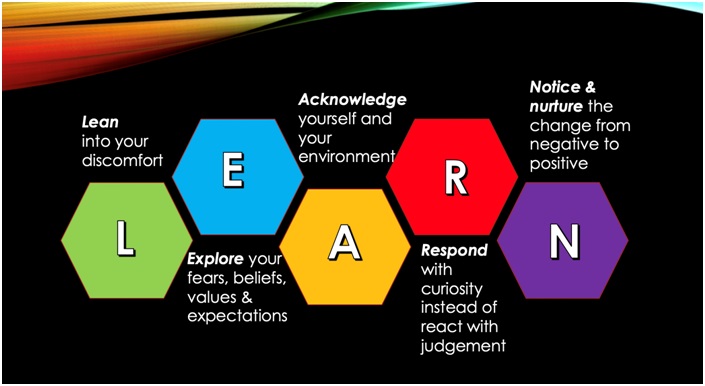A Coaching Model Created by Ildiko Benko
(Executive Coach, SWITZERLAND)

Why Learn?
If knowledge is power, learning is your superpower,
As a former teacher and as an avid lifelong learning promoter myself, I tend to agree with this quote by Jim Kwik, the Brain Coach.
According to Wikipedia, “learning is the process of acquiring new understanding, knowledge, behaviors, skills, values, and preferences. Human learning starts at birth (it might even start before) and continues until death as a consequence of ongoing interactions between people and their environment.”[1]
It is undeniable that learning is fundamental to any kind of personal development in any kind of environment. When I started my Coaching journey I immediately recognized a familiar pattern in the coaching process. To me, Coaching is all about learning: learning about yourself, the situation, the environment, and then use this learning for personal growth. It was only fitting that I named my Coaching Model after something I personally know, truly believe in, and can stand fully behind, knowing it has worked for me and it can work for others too.
Who is it for?
This model is for anyone who would like to achieve greater clarity, focus, and self-awareness to be able to manage their own emotions and those of others using the power of Emotional Intelligence (EI).
What is it about?
The LEARN coaching model is using an Emotional Intelligence approach, divided into five steps and each of these is designed to guide the Client towards self-awareness to help avoid a so-called “emotional hijacking” situation triggered by the fight or flight response of the amygdala, our emotional processor[2]:
The five steps are the following:
L – lean into your discomfort
E – explore your fears, beliefs, values & expectations
A – acknowledge yourself and your environment
R –respond with curiosity instead of reacting with judgment
N – notice & nurture the change from negative to positive

The first step is: lean into your discomfort.
To do this, you will need to leave your comfort zone, which will not be easy but we will do it together. Only when you are ready to face your triggers will be able to come up with a plan and move into action later on. Triggers can take many forms, identifying them at this stage will help to define what we need to improve upon in our work together.
The second step is: explore your fears, underlying beliefs, values & expectations.
This is about you: you must be honest with yourself. How do you see the world? How do you think the world sees you? What are your thoughts and feelings? Where are they coming from? What do you want? What do you need? Do not be afraid of “bad” thoughts or feelings, they are telling you something!
The third step is: acknowledge yourself and your environment.
After having been hard on yourself and others around you, now it is time to be more forgiving and practice some pro-active empathy. Stay calm and be open, and try to put yourself in the shoes of others. How does that make you feel?
The fourth step is: respond with curiosity instead of reacting with judgment.
Judgment destroys a trusting space and sends you to a defensive mode. It does not have to be this way. We are designed to react to triggers but you can choose the how. This is your freedom, to choose what is most useful to you and it is only one deep breath away. Try to remove yourself from the triggers identified to get a more objective view to help identify ways forward. This works best when you can physically move away from an unpleasant situation but sometimes we are just not able to. In those cases, a small breathing exercise which we will learn can be of great help.
The fifth step is: notice & nurture the change from negative to positive.
Now it is time to connect the dots (e.g. recognize patterns, contradictions) and appreciate the learning you are having about yourself and the situation. Identify what matters and let the rest go. Take back the control over yourself and bring back the lightness to the situation. Remember, emotions are contagious, so lead by example! Choose a positive response over a negative reaction and notice and appreciate how your environment gets positively influenced by the change. How does that make you feel?
This is it: Five simple but not easy steps. The aim of my Coaching Model is twofold: to show that becoming a victim of emotional hijacking is a choice and as such it is avoidable and that enhancing Emotional Intelligence is possible and the key to personal growth. Setting your mind on doing both will certainly help you succeed in your personal and professional life alike.
Resources
[1]https://en.wikipedia.org/wiki/Learning
[2]Goleman, Daniel: Emotional Intelligence: Why it can matter more than IQ, 2009, Bloomsbury Publishing Plc (electronic publication)